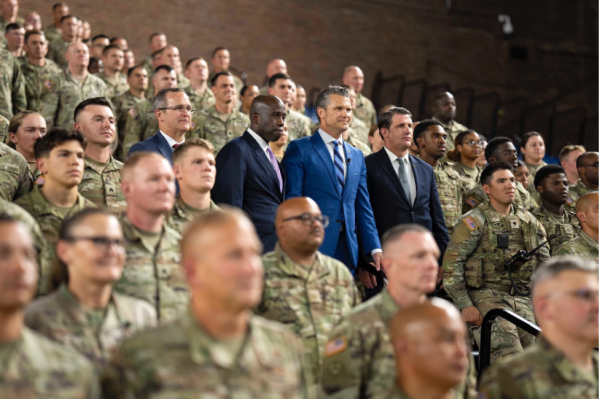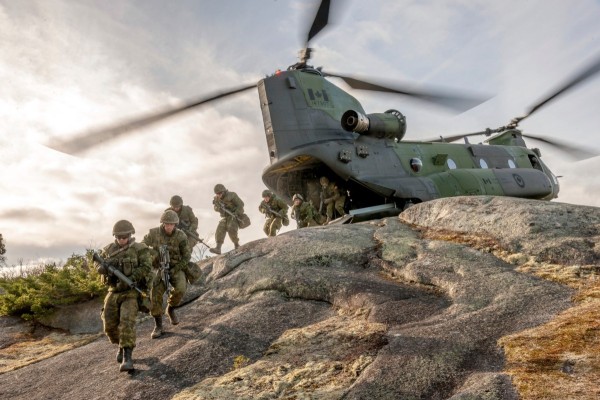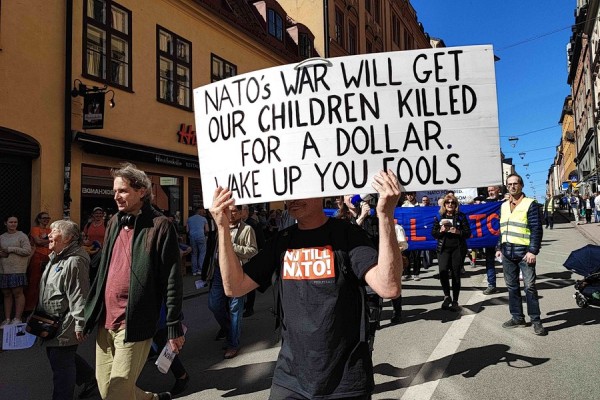Canada flying in lockstep with the United States
Schalk: Carney’s defence choices will deepen dependence and weaken sovereignty

An F-35B Lightning II fighter jet prepares to take off from the flight deck of the USS America in the South China Sea. Photo courtesy the United States Pacific Fleet/Flickr.
During his campaign for prime minister, Mark Carney vowed that the era of “deepening integration” between the Canadian and US militaries was “over.” US President Donald Trump’s open disrespect for Canadians—and his promise to annex Canada through economic force—united the majority of the country against the US and drove Carney’s victory over far-right Conservative leader Pierre Poilievre.
The Carney government’s recent actions, however, including the near certain purchase of US-made F-35s, reveal his campaign promises for what they were: a calculated political rug pull.
Carney’s record as an orthodox neoliberal—and his hands-on role in US-led destabilization efforts against Venezuela while serving as governor of the Bank of England—should have tempered expectations that he would seek to reshape Canadian foreign policy or challenge American business elites. After the election, in fact, Carney released a list of his assets, showing investments in 567 organizations, 92 percent of them based in the US.
Rather than insulating Canada from an increasingly unpredictable White House, Carney’s policies appear to have reinforced Canadian alignment with the US in military, economic, and foreign policy matters. Diplomatically, meanwhile, Carney is full of praise for Trump, who last month reiterated his desire to annex Canada to the United States.
Carney’s “elbows down” approach was on full display during his October 8 visit to Washington. At a joint press conference with Trump, he offered unreserved praise for the president’s agenda, calling him a “transformative” leader and a peacemaker—even as Trump bombed civilian boats in the Caribbean with help from Canadian-supplied sensor systems. Carney also reaffirmed Ottawa’s backing for US-Israeli strikes against Iran, actions that were illegal and unprovoked.
Few matters expose the true character of Carney’s campaign promises like the looming F-35 purchase. In June 2023, the Justin Trudeau government signed a contract with Lockheed Martin to buy 88 F-35 fighter jets for $19 billion, with a lifecycle cost of $73.9 billion. Many Canadians have long opposed the F-35 deal for a variety of reasons, including the continued erosion of Canadian sovereignty to the US, the imprudence of spending billions on fighter jets while food insecurity, homelessness, and the cost of living rise, the environmental impact of these fuel-intensive aircraft, and the risks of investing in new weapons of war amid rising tensions between major powers.
Amid Trump’s belligerence, the Carney government ordered a review of the F-35 purchase, with reports suggesting Canada might switch to the Swedish Gripen aircraft. Canadians concerned about climate change, global tensions, and economic stagnation understandably argue that the fighter jet purchase should be scrapped entirely. Even so, replacing US jets with Swedish ones could create some much-needed distance between the US and Canadian militaries.
Carney has so far offered no indications that the F-35 deal will be scrapped. On October 12, his Chief of Defence Staff Jennie Carignan stated that “We are working towards this acquisition.” And it’s not just F-35s. The Liberal government is also purchasing the following US-made military equipment: the High Mobility Artillery Rocket System (HIMARS) ($714 million); destroyer combat systems ($2.3 billion); 17 Boeing surveillance planes ($10.4 billion); and US-made light tactical vehicles ($220 million).
On top of this, Canada will likely be participating in the US government’s Golden Dome missile defence system, which Trump claims will cost Canada $61 billion—and Carney continues to uphold the five percent of GDP military spending target advocated by Trump.
It is undeniable that Carney, the man who was elected to defend Canada from US pressure, has folded over and over on Trump’s military spending demands. His trade relationship with the US president has also been marked by capitulation after capitulation—for example, repealing the digital services tax at Trump’s request and lifting counter-tariffs against the US.
Considering Carney’s accommodation of Trump’s demands and the longstanding pro-US orientation of the Canadian Armed Forces, the F-35 purchase seems all but inevitable. Even the US Government Accountability Office (GAO) has criticized the F-35 program, which is “$6 billion over budget and five years behind schedule.” The GAO report on F-35s stated: “After nearly 20 years of aircraft production… the F-35 program continues to overpromise and underdeliver.”
The Canadian military is already familiar with the challenges of cost overruns and project delays. The Royal Canadian Navy’s program to build 15 new warships, for instance, has faced continual setbacks and ballooning expenses—from an initial estimate of $26 billion to $80 billion today. As with the F-35s, the US will control key equipment on these ships.
US Ambassador to Canada Pete Hoekstra—whose recent visit to Winnipeg prompted large protests—has claimed that a Canadian decision to abandon the F-35s would pose a threat to NORAD. “If Canadians are flying one airplane, we’re flying another airplane, it’s no longer interchangeable,” said Hoekstra. “And so, that might even threaten NORAD.” Were Carney to unexpectedly cancel the purchase, it is easy to predict Trump’s likely response: he would frame Canada as the one threatening US national security, claiming that Canada is undermining NORAD.
As Ottawa Citizen reporter David Pugliese notes: “The F-35 is seen by Canadian air force officers as an important purchase as it allows them to seamlessly integrate with their US counterparts. The aircraft also further ties Canada into the American military system as the US controls all software upgrades on the aircraft and owns the parts for the planes, even those to be stored in Canada.”
Some analysts warn that US control over F-35 parts could allow Washington to command Canadian-owned planes, though the pro-US character of previous governments makes this unlikely. The Canadian military has long supported US interventions abroad, from Korea to Ukraine. Yet Carney’s deference feels particularly striking.
At a moment when Canadians expected a government that might challenge US influence and reset foreign policy, they have instead seen more grovelling to Washington, more involvement in military conflicts, and more acquisitions that bind Canada to the US, heighten global tensions, and divert resources from climate action and pressing social needs. In short, more of the same.
Owen Schalk is the author of Targeting Libya: How Canada went from building public works to bombing an oil-rich country and creating chaos for its citizens, an exploration of Canada’s pivotal yet little-known role in Libya’s history, now available from Lorimer Books.










